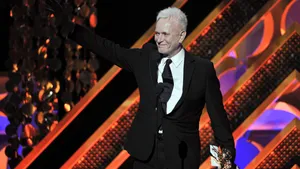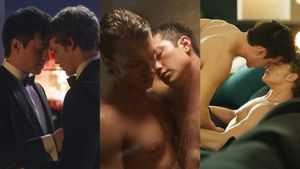CONTACTAbout UsCAREER OPPORTUNITIESADVERTISE WITH USPRIVACY POLICYPRIVACY PREFERENCESTERMS OF USELEGAL NOTICE
© 2025 Equal Entertainment LLC.
All Rights reserved
All Rights reserved
By continuing to use our site, you agree to our Privacy Policy and Terms of Use.
We need your help
Your support makes The Advocate's original LGBTQ+ reporting possible. Become a member today to help us continue this work.
Your support makes The Advocate's original LGBTQ+ reporting possible. Become a member today to help us continue this work.
Bruce and Charles
For most of my childhood, I was in love with my best friend, Bruce.
Bruce was a tall, blond Texan with the windswept good looks of a billboard model, and sometimes I would stare at him when he wasn't looking, just to memorize his face, with its slight Modigliani slant, the dash of asymmetry that saved him from Ken-doll perfection and instead gave him a slight perpetual scowl, the kind that catapulted him into the ranks of almost intolerable beauty, alongside James Dean and the rebel heroes of the French new wave.
My mother was always gracious to my friends, but she viewed Bruce with suspicion. Maybe it was the way he squealed past our house in his purple Chevy Monza, or his innate contempt for authority. Maybe he was just too pretty for a boy. Conversely, Mrs. C. used to warn Bruce against me. "Doug doesn't play a team sport," she'd say ominously, "and he spends all his time with that theatre crowd." Was I corrupting him, or was he corrupting me? It didn't matter. Either way, our mothers' shared belief that we were exerting an unwholesome influence over one another bonded us together with the force of Super Glue.
But Bruce did more than frighten my mother and set my adolescent pulse racing. He was my arbiter in the world of All Things New and Fabulous.
In 1979 Bruce rang me during dinner and said, "You've got to come over right away. I'm listening to this bootleg record, this new singer, she's amazing, and she's going to totally upset all the Catholics because she calls herself Madonna. Can you believe that? Madonna?"
Another time he summoned me to his house because he had -- in his words --"redecorated his room." When I arrived, he opened his bedroom door with the same hushed reverence a monk might show when unlatching the gate to the reliquary at Sacre Coeur. Hanging from the ceiling were thirty or forty plastic dishracks, bolted upside down, and filled with brightly colored disposable plates, saucers, and cups, which he'd placed in the oven just long enough to melt ever so slightly; they dangled over us like so many Tupperware stalactites. I looked at him, dumbstruck. "Pop art," he whispered softly.
In high school Bruce became my first director. For drama class we decided to make our own film, using his father's Brownie camera. The story we chose was universal: a first date. A randy boy would make unseemly moves on a hapless virgin. But the shocking coup de theatre? I'd play both roles! As the predatory teen, I wore knickers with a varsity sweater and a jaunty cap perched sideways on my head. For the girl, we raided his sister's Halloween closet and found a gingham dress and a blond wig with corkscrew ringlets. Through the miracle of editing (which in those days was accomplished with some tape and a razor blade), I would appear to be seducing myself! When the film debuted at McCulloch Middle School to a room filled with seventh graders, it was a rousing success.
It was in college that Bruce granted me another seminal first. I was struggling to come out of the closet, and Bruce paid me an all-important visit during spring break. He'd proudly proclaimed himself gay years before, and I urgently needed his help. "I've told everyone I'm gay," I blurted to him. "My family, my friends ... but it doesn't make me feel any better."
"Why not?" he asked.
"Because it's a wholly academic admission," I told him. "I don't have any experience to confirm it. I've never ... "--my heart stopped beating but my mouth kept moving--" ... had sex with a man."
A sly smile crept over his face. "Well," he said, clicking off the light, "Let's take care of that, shall we?"
That was the first and only time we slept together. On one level, I was devastated that we never became lovers. But on another level, I took it in stride. Our relationship was long and complicated, but our roles had become concretized over the years: he was the Golden Boy, the A-list gay, who matched the lifestyle spreads in After Dark magazine. I was his bookish best friend, the neurotic artist, homely but consoled by my pretensions of intellect and talent. He gave me beauty; I gave him gravitas. We exchanged attributes in lieu of bodily fluids; it was our unspoken pact. And both of us were far too comfortable inhabiting those tropes to risk disaster and fashion new ones.
Bruce and I went to college in different states and missed one another fiercely, so we agreed not to repeat that mistake in graduate school. I'd study theatre at the Tisch School of the Arts, and he'd head uptown to Columbia for a medical degree. Together, we'd conquer New York, plumbing its hidden corners, insinuating ourselves into its demimonde.
One night Bruce announced, "I've got theater tickets. There's this troupe near Sheridan Square that we just have to see."
"How did you hear about them?" I asked.
"Kip the towel boy," Bruce answered, confirming that his late-night social contacts far exceeded my own. "He says they're the last authentic thing left in the West Village."
From the outside, the theatre didn't look like much -- little more than a storefront with cheap wooden letters that spelled out RIDICULOUS THEATRICAL COMPANY. Lingering near the door, goths, gay couples with matching muttonchops, leftist neighborhood types with gray ponytails and fringe, and a few befuddled tourists who'd been lured downtown by half-price coupons. Inside there was a cramped vestibule and a tiny ticket window with bars; rather than a real person, I half-expected to find an automated gypsy with a coin-drop crystal ball.
After we picked up our tickets, an usher gestured to a staircase that spiraled down into the basement. It was painted in an explosion of colors and led straight into the psychedelic lobby below. I felt like I'd strayed onto the back lot of an especially trippy Sid and Marty Krofft show. There were placards bearing reviews, most notably from the oracular New York Times.
"The company's been around for years," Bruce informed me. "Now they're on the dangerous brink of mainstream success."
We shuffled our way into the house; the ceilings were unusually low, and the seats looked like they'd been salvaged from a fire sale. The stage itself tilted toward the audience at a precarious angle, as though a single misstep could send an actor sliding into your lap. But the red curtain with gold fringe belied these humble surroundings; it harked back to an era when the theatre was the province of Kings.
The houselights dimmed; we heard a thunder crack, and the howling of the wolves across the moors. The play began.
The Mystery of Irma Vep billed itself as a penny dreadful. In it, newlywed Lady Enid arrives at Mandacrest, the English manor house of her husband Lord Edgar. She expects a life of bucolic splendor, but instead she falls headlong into a nightmare. Edgar's late wife, the titular Irma, still haunts the grounds, and she's none too happy that a new bride is attempting to usurp her place. Poor Lady Enid is mortified; what vengeful spirits has she unwittingly bestirred? For solace, she turns to the housemaid Jane. But Jane is a surly old crow reminiscent of Mrs. Danvers in Hitchcock's Rebecca, unable to comfort Enid because of the twisted love she still bears for her dead mistress. Meanwhile, Nicodemus, the butler, stomps about the chilly old house on a wooden leg -- a replacement for one lost during an unfortunate interlude with a werewolf -- spouting ill omens and tales of a murdered child. When Lady Enid attempts to unlock the many secrets of Mandacrest, she learns that even Lord Edgar is not who he seems. Is he willfully attempting to drive his second wife mad? (Cue the organ music!) Before it all comes to a suitably blood-soaked conclusion, our heroine has fought off wild dogs, exposed vampires, and even detoured as far away as Egypt to conceal herself inside a fourteenth-century sarcophagus. (Don't ask.) The play's influences were many: Daphne du Maurier, Matthew "The Monk" Lewis, Hammer Film Productions, and the French Grand Guignol. Careening from arch drawing-room comedy to Vincent Price horror flick, the writing navigated genres with the same deceptive ease as a ship's captain navigating the high seas.
The stagecraft was simple but ingenious: the set was peppered with trap doors, hidden mirrors, and surprise passageways. But the show's chief, virtuosic pleasure? Two actors played all the parts. One happened to be the playwright himself, Charles Ludlam. In a wig and plunging neckline (revealing his hirsute decolletage), his Lady Enid swept onto the stage with all the authority of Lynn Fontanne. As Nicodemus, he'd lurch across the stage in his prosthetic, comic wisps of hair dancing over an otherwise bald scalp, his eyes as wide and incredulous as a lemur's. He articulated each character with hilarious precision by elevating his voice an octave or screwing his rubber face into a wholly new profile. (I blushed to recall that I attempted the same trick once, in humbler circumstances, in front of Bruce's camera. Now I was getting a master class.)
Even in my youth, I knew Ludlam was that rare, indispensable creature: a bona fide clown. Not of the cloying, circus variety, no, but a clown in the tradition of Bert Lahr or Charlie Chaplin, consummate artists who can make us laugh uproariously at our own foibles and in the same instant break our hearts.
Ludlam's partner in crime (and later, I would learn, his longtime lover) was Everett Quinton. He not only kept pace with his formidable costar, he'd designed all the costumes, too. He'd exit stage right as Lord Edgar in his morning coat and cravat, only to reenter stage left as Jane in her immaculate apron and maid's cap. Mr. Quinton was a master not only of comic timing, but of Velcro.
Along with the rest of the audience, Bruce and I laughed until our ribs ached; but our reaction was more profound then mere amusement. For the first time in our lives, we felt truly at home.
Maybe it was the hilariously two-dimensional set; hand painted with its many booby traps, it didn't look so dissimilar from the flats Bruce and I had painted back in Texas for the senior play. Maybe it was the gleeful, unabashed cross-dressing. Maybe it was the coded gay references that glittered in the text like so many hidden jewels. Whatever it was that made us feel such acute belonging, we knew one thing: when the curtain call ended, we couldn't bear the thought of going. Leaving the theatre after a peak experience is always a wistful affair; but we sat in our seats for a long time, too smitten to even stand.
After that fateful evening, Bruce and I became scholars of the Ridiculous. We read up on the company's early work, far more outre than even the outrageous Irma Vep -- plays with delicious, profane titles like Turds in Hell and Isle of Hermaphrodites. We found photos of other company members: John Vaccaro, the secondhand book merchant and tempestuous director who'd originally founded the group; winsome leading lady Black-Eyed Susan; and the sexually ambiguous Mario Montez, star of the Jack Smith film Flaming Creatures. We vowed to descend that kaleidoscopic staircase again and again, to keep abreast of the company's future work.
Soon we had an established ritual. We'd meet at the Monster, a gay bar in Sheridan Square known for its cheerful seediness and show-tune sing-alongs. A quick drink, and at curtain time, we'd cross the street. After the play, we'd grab a late supper, usually at a coffee shop, and discuss the play over greasy fries in a vinyl banquette.
"There was an announcement in the Voice," Bruce told me one evening, dabbing the ketchup from his chin. "Next up at the Ridiculous? An adaptation of Flaubert's novel Salammbo."
"Have you read it?" I asked.
"No," said Bruce, "But get this." He arched an eyebrow and leaned over the table, lowering his voice to a confidential tone. "The production features live doves, six naked bodybuilders, and a five-hundred-pound actress, totally nude, covered in prosthetic scars to simulate the last, fatal stages of leprosy."
What further enticement did we need?
We bought our tickets early to three performances over the course of the show's run. The reviews for Salammbo were as savage as the notices for Irma Vep had been ecstatic. But in our dark little hearts, we preferred it. It had a decadence, an unapologetic extravagance, that spoke to us as young gay men who were both exhilarated and terrified by our own outsider status in the larger culture.
Bruce became infatuated with one particular actor in Salammbo. His name was Philip Campanaro, and he played Matho the Barbarian. Mr. Campanaro's negligible acting skills and thick Noo Yawk accent were mitigated by a chiseled Italian face and the body of a veritable Tarzan. He performed his role in a loincloth seemingly made of kite string, and his only previous show-business experience had been a pictorial in a magazine with the evocative title Torso. He wooed the heroine (Ludlam, of course) with lines like "Come to me, I love thee more than life, virgin who meltest my soul." Onstage, Salammbo swooned. In row F, three seats off the aisle, so did Bruce.
A few months later my telephone rang.
"Guess what?" Bruce exclaimed. "Philip Campanaro is starring in the next Ridiculous show. It's a send-up of James M. Cain film noirs called The Artificial Jungle. It's set in a pet shop. There's a piranha tank onstage, and a six-foot-tall drag queen who does back flips."
"We are so going," I said.
Advocate.com readers can order The Play That Changed My Life from ApplausePub.com and get 25% off plus free shipping. Enter promo code APPL1 at checkout. Free shipping is by least expensive ship method and applies to U.S. orders only.
From our Sponsors
Most Popular
Bizarre Epstein files reference to Trump, Putin, and oral sex with ‘Bubba’ draws scrutiny in Congress
November 14 2025 4:08 PM
True
Jeffrey Epstein’s brother says the ‘Bubba’ mentioned in Trump oral sex email is not Bill Clinton
November 16 2025 9:15 AM
True
Watch Now: Pride Today
Latest Stories
Rachel Maddow on standing up to government lies and her Walter Cronkite Award
December 15 2025 3:53 PM
Beloved gay 'General Hospital' star Anthony Geary dies at age 78
December 15 2025 2:07 PM
Rob Reiner deserves a place in queer TV history for Mike 'Meathead' Stivic in 'All in the Family'
December 15 2025 1:30 PM
Culver City elects first out gay mayor — and Elphaba helped celebrate
December 15 2025 1:08 PM
Texas city cancels 2026 Pride after local council rescinds LGBTQ+ protections
December 15 2025 12:55 PM
North Carolina county dissolves library board for refusing to toss book about a trans kid
December 15 2025 11:45 AM
Florida and Texas launch 'legal attack' in push to restrict abortion medication nationally
December 15 2025 11:18 AM
No, Crumbl is not Crumbl-ing, gay CEO Sawyer Hemsley says
December 15 2025 10:12 AM
11 times Donald Trump has randomly brought up his ‘transgender for everybody’ obsession
December 15 2025 9:22 AM
The story queer survivors aren't allowed to tell
December 15 2025 6:00 AM
Rob Reiner, filmmaker and marriage equality advocate, and wife Michele dead in apparent homicide
December 15 2025 1:08 AM
As he turns 100, Dick Van Dyke is an unsung gay idol from an era of Judy, Liza, and Cher
December 13 2025 10:01 AM




































































Charlie Kirk DID say stoning gay people was the 'perfect law' — and these other heinous quotes